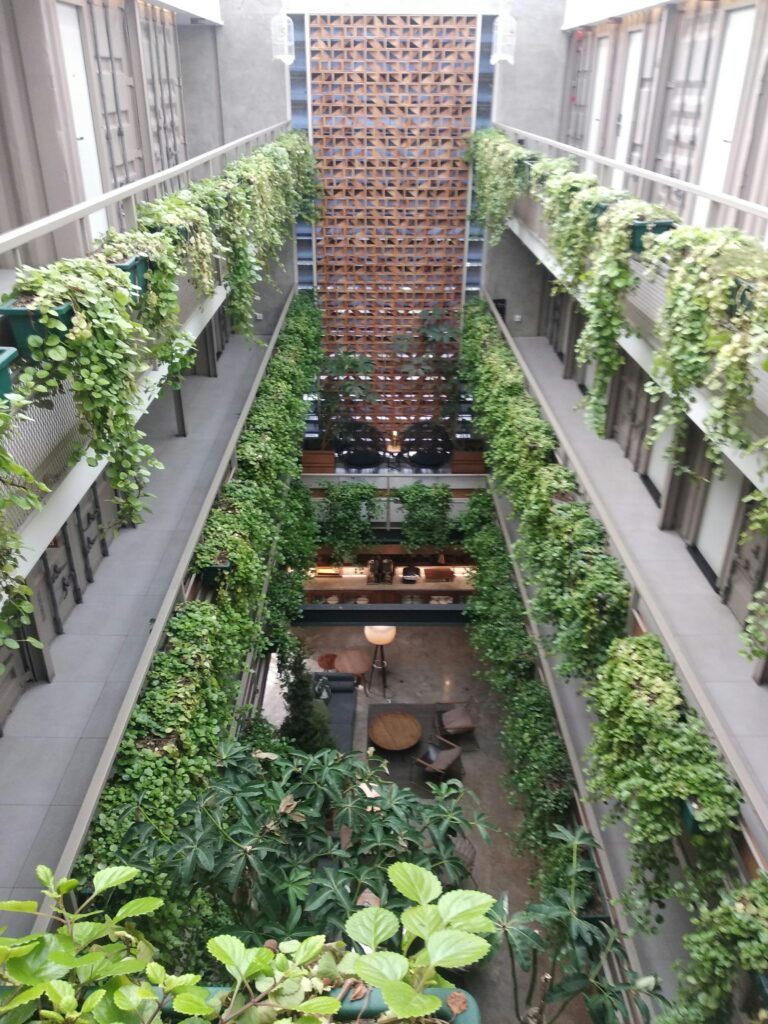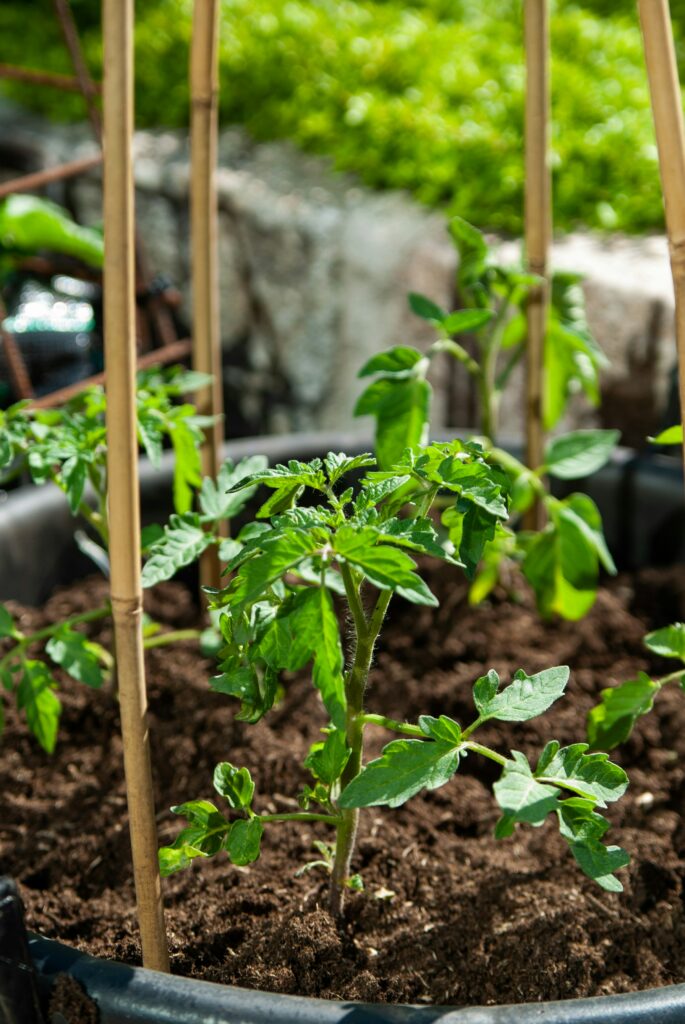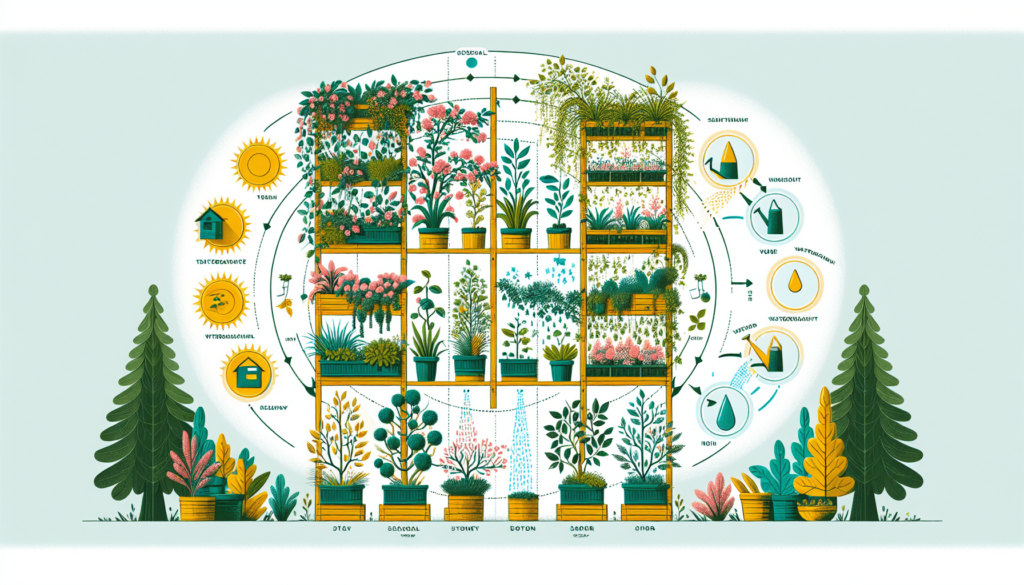Disclosure: As participants in the Amazon Associates Program, we earn from qualifying purchases. This means when you click on an Amazon link on this page and make a purchase, we receive a commission. This doesn’t affect the price you pay but it does help us to keep producing the content you love to see. We always aim for honesty and transparency in everything we do, and your support means the world to us. Thank you for helping us grow and for being part of our community.
In the world of vertical gardening, selecting the right plants for different seasons is a crucial step towards maintaining a flourishing oasis in the sky. At our website, we understand the importance of this decision and strive to provide you with the knowledge and resources to make informed choices. Through our comprehensive FAQ section, we offer insights into the process of choosing plants that will thrive in each seasonal change, ensuring your vertical garden remains vibrant and enchanting all year round. Whether you’re a beginner or a seasoned gardener, let us guide you through the intricacies of plant selection, watering techniques, and maximizing your vertical space. Join our community of like-minded green enthusiasts and embrace the magic of transforming spaces with the captivating beauty of vertical garden kits.

This image is property of images.unsplash.com.
Understanding the Climate
When it comes to choosing plants for your vertical garden, it is crucial to understand the climate in which you live. The climate plays a significant role in determining which plants will thrive and which ones will struggle to survive. To ensure success, here are a few key factors to consider:
Know your hardiness zone
One of the first steps in understanding your climate is to know your hardiness zone. Hardiness zones are determined based on the average minimum winter temperature in a specific geographical area. By identifying your hardiness zone, you can choose plants that are more likely to withstand the winter temperatures in your region.
Research the average temperatures and weather patterns
In addition to understanding your hardiness zone, it is beneficial to research the average temperatures and weather patterns of your area throughout the year. This information will give you a better idea of the extreme temperatures and weather conditions your plants may encounter. By selecting plants that are well-suited to these conditions, you can increase their chances of thriving in your vertical garden.
Consider the microclimate of your vertical garden
Beyond the general climate of your region, it is important to consider the microclimate created by your vertical garden. Factors such as the amount of sunlight, wind exposure, and temperature variations within your garden can vary from those of the surrounding environment. By understanding these microclimate distinctions, you can select plants that will flourish in the unique conditions of your vertical garden.
Selecting Plants for Spring
Spring is a season of growth and renewal, making it an ideal time to introduce new plants to your vertical garden. Here are a few things to consider when choosing plants for the spring season:
Choose plants that thrive in cooler temperatures
As spring is characterized by milder temperatures compared to both winter and summer, it is a good idea to select plants that thrive in cooler weather. Plants such as lettuce, spinach, and snapdragons are known for their tolerance to slightly lower temperatures and are excellent choices for a spring vertical garden.
Consider plants with vibrant flowers
Spring is often associated with vibrant blooms and bursts of color. Adding plants with vibrant flowers, such as tulips, daffodils, and pansies, can add a cheerful and lively element to your vertical garden during the spring season. Remember to consider the size of these plants and ensure they can be accommodated within your vertical space.
Select plants that have an early growing season
Many plants have varying growing seasons, and some may take longer to reach maturity. When selecting plants for your spring vertical garden, opt for those that have an early growing season. This way, you can enjoy the fruits, vegetables, or flowers of your labor sooner rather than later. Examples of plants with an early growing season include radishes, peas, and sunflowers.

This image is property of images.unsplash.com.
Choosing Plants for Summer
Summer is a season characterized by longer days, higher temperatures, and more intense sunlight. When selecting plants for your vertical garden during the summer months, consider the following factors:
Opt for heat-tolerant plants
With the rising temperatures of summer, it is essential to choose plants that can tolerate heat. Heat-tolerant plants are better equipped to withstand the scorching sun and higher temperatures. Some examples of heat-tolerant plants include marigolds, zinnias, and succulents. These plants not only add color to your vertical garden but also thrive in hot and dry conditions.
Select plants that can handle direct sunlight
Sunlight is abundant during the summer months, so it is important to choose plants that can handle direct sunlight. Sun-loving plants, such as tomatoes, peppers, and lavender, not only thrive in sunlight but also benefit from the warmth it provides. Be sure to position your vertical garden in an area where it receives ample sunlight throughout the day for maximum growth and productivity.
Look for plants with a longer flowering period
During the summer, it is enjoyable to have plants that continue to bloom and bring color to your vertical garden. Look for plants with a longer flowering period to create a visually appealing and vibrant display throughout the summer season. Examples of plants with extended bloom times include petunias, cosmos, and black-eyed Susans.
Picking Plants for Autumn
As summer comes to an end and temperatures begin to cool, it’s time to consider transitioning your vertical garden for the autumn season. Here’s what to keep in mind when selecting plants for your autumn vertical garden:
Choose plants that can withstand cooler temperatures
As temperatures start to drop during autumn, it is important to choose plants that can withstand cooler temperatures. Opt for plants that are more resilient to the cold, such as kale, Swiss chard, and pansies. These plants can thrive in lower temperatures and add vibrant colors to your vertical garden during the autumn months.
Look for plants with fall foliage colors
Autumn is famous for its stunning display of warm and vibrant foliage colors. Incorporate plants with fall foliage colors into your vertical garden to capture the essence of the season. Trees and shrubs such as maple, birch, and dogwood are known for their beautiful autumn foliage and can be excellent additions to your vertical garden.
Consider plants that produce berries or seeds
Autumn is the time when many plants bear fruit and develop seeds. By selecting plants that produce berries or seeds, you can introduce a different element of interest to your vertical garden during the autumn months. Plants like blackberries, grapes, and pumpkins can not only provide a harvest but also add visual appeal to your garden.

This image is property of images.unsplash.com.
Selecting Plants for Winter
Winter brings unique challenges to gardening, but with careful plant selection, you can still enjoy a thriving vertical garden during this season. Consider the following factors when choosing plants for your winter vertical garden:
Choose cold-hardy plants
Winter brings freezing temperatures, so it is crucial to choose plants that can withstand the cold. Look for cold-hardy plants that are adapted to winter conditions. Evergreens such as junipers, holly, and spruce can add texture and color to your vertical garden throughout the winter season. These plants retain their foliage and provide interest when other plants may be dormant.
Consider evergreen plants for year-round interest
Evergreen plants are known for their ability to retain their foliage throughout the year, including the winter months. By incorporating evergreen plants into your vertical garden, you can maintain a vibrant appearance even during the dormant winter season. Consider using plants like boxwood, yew, or ivy, which offer year-round interest and keep your vertical garden visually appealing.
Look for plants with interesting bark or structure
During the winter months, when foliage is scarce, plants with interesting bark or structure can add visual interest to your vertical garden. Birch trees, for example, have striking white bark that stands out against the winter landscape. Other plants with unique bark patterns or architectural shapes, such as contorted filberts or corkscrew willows, can also be great choices for adding winter appeal to your vertical garden.
Considering Planting Techniques
When it comes to vertical gardening, selecting appropriate planting techniques is essential for the growth and success of your plants. Here are some important considerations:
Choose plants with shallow roots for vertical gardens
Vertical gardens typically have limited space for root growth, so it is important to select plants with shallow root systems. This ensures that your plants can thrive within the confined space of a vertical garden. Planting options such as herbs, lettuce, and strawberries are well-suited to vertical gardening due to their shallow root systems.
Consider using a mix of annuals and perennials
When planning your vertical garden, consider incorporating a mix of annual and perennial plants. Annual plants typically have a shorter lifespan, while perennial plants can survive and thrive for multiple years. By including both types of plants, you can enjoy the continuous bloom and variety of annuals while ensuring a long-term green presence with the perennial plants.
Explore hydroponic or aeroponic systems for more control
If you are looking for precise control over the planting environment and water distribution, consider exploring hydroponic or aeroponic systems for your vertical garden. These systems allow you to provide nutrients directly to the plants’ roots without the need for soil. Hydroponic and aeroponic systems can be a great option for those who want to maximize plant growth and minimize water usage in their vertical garden.

Assessing Lighting Conditions
Lighting conditions play a crucial role in the growth and overall health of your plants. Consider the following factors when assessing the lighting conditions for your vertical garden:
Evaluate the amount of sunlight your vertical garden receives
The amount of sunlight your vertical garden receives will largely depend on its location. Different plants have varying light requirements, so it is important to evaluate the amount of sunlight your vertical garden receives throughout the day. Some plants thrive in full sun, while others prefer partial shade. By understanding the light conditions of your vertical garden, you can select plants that will thrive in those conditions.
Choose plants that match the light requirements
To ensure optimal growth and development, choose plants that are well-suited to the lighting conditions of your vertical garden. For example, if your vertical garden receives full sun for the majority of the day, select sun-loving plants like tomatoes or peppers. Alternatively, if your vertical garden is in a shaded area, consider shade-tolerant plants such as ferns or hostas. Matching plant light requirements with the available sunlight will greatly enhance the success of your vertical garden.
Consider using artificial lighting for indoor vertical gardens
If your vertical garden is located indoors or in an area with limited natural light, supplementing with artificial lighting can be a great solution. LED grow lights or fluorescent lights can provide the necessary light energy for photosynthesis, allowing your plants to thrive even in low-light conditions. When using artificial lighting, make sure to choose lights that provide a full spectrum of light for well-rounded plant growth.
Considering Watering and Drainage
Watering and drainage are crucial aspects of plant care in any type of garden, including vertical gardens. Here are some points to consider when it comes to watering and drainage for your vertical garden:
Choose plants that can handle the watering frequency
Different plants have different watering needs, so it is important to choose plants that can handle the watering frequency of your vertical garden. Some plants, like succulents, prefer drier conditions and can tolerate longer periods between waterings. On the other hand, plants like ferns or hydrangeas may require more frequent watering. By selecting plants that match your watering habits, you can ensure that your vertical garden stays healthy and hydrated.
Consider the watering system of your vertical garden
Vertical gardens offer versatility when it comes to choosing a watering system. Depending on your preferences, you can opt for a drip irrigation system, a self-watering planter, or a manual watering system. Drip irrigation systems can provide a consistent water supply to your plants, while self-watering planters can help maintain proper moisture levels. Choose a watering system that aligns with your lifestyle and the needs of your selected plant varieties.
Ensure proper drainage for each plant
Proper drainage is essential in preventing waterlogging and root rot in your vertical garden. Ensure that your vertical garden has adequate drainage by using well-draining soil and selecting containers or pockets with drainage holes. For plants that require higher moisture levels, consider adding a layer of pebbles or perlite at the bottom of the container to improve drainage. Proper drainage ensures that excess water can escape, preventing potential damage to your plants.

Accounting for Space and Growth
When planning your vertical garden, it is important to consider the available space and the growth habits of your selected plants. Here are some factors to consider:
Consider the vertical space available
Vertical gardens make the most of limited space, but it is still crucial to consider the vertical space available for your plants. Some plants may require more vertical growing space than others due to their growth habits. Climbing plants like ivy or sweet peas may reach considerable heights, while compact herbs like thyme or basil may require less vertical space. Take into account the potential growth and size of your plants to ensure they have enough room to flourish.
Choose plants that won’t overcrowd the garden
Overcrowding your vertical garden with too many plants can limit their access to light and airflow, leading to stunted growth or increased susceptibility to diseases. Select plants that will not overcrowd your vertical garden, allowing each plant to receive adequate space and resources. Consider the mature size of your plants and ensure that they have enough room to grow without competing for resources.
Account for the growth habit and size of each plant
Every plant has a unique growth habit and size, and it is important to consider these characteristics when planning your vertical garden. Some plants, like ivy or morning glories, have a trailing or climbing growth habit, while others, like zinnias or daisies, have an upright or bushy growth habit. Understanding the growth habits and sizes of your chosen plants will help you arrange them in a way that maximizes space and creates an aesthetically pleasing vertical garden.
Seeking Expert Advice
Regardless of your gardening experience, seeking advice from experts can provide valuable insights and guidance for your vertical garden. Here are a few ways to seek expert advice:
Consult local nurseries or gardening centers
Local nurseries and gardening centers are excellent resources for specialized knowledge on plants and gardening techniques. The experts at these establishments can provide valuable advice on plant selection, care, and maintenance specific to your region. They can also recommend plants that are well-suited to your climate and help troubleshoot any issues you may encounter in your vertical garden.
Join online gardening communities and forums
The internet offers a wealth of knowledge and an opportunity to connect with fellow gardeners through online communities and forums. Joining these communities can provide access to a vast network of experts and enthusiasts who are eager to share their experiences and offer advice. Participating in discussions, asking questions, and sharing your own insights can enrich your vertical gardening journey and help you make informed decisions.
Attend workshops or classes on vertical gardening
Workshops or classes on vertical gardening are a great way to learn from experts in a hands-on setting. These events often cover various aspects of vertical gardening, including plant selection, planting techniques, and maintenance. Participating in workshops or classes allows you to gain practical knowledge and interact with professionals who can provide personalized guidance based on your specific needs.
By incorporating these expert insights and seeking advice from experienced gardeners, you can enhance your vertical gardening skills and ensure the success of your vertical garden.
In conclusion, choosing plants for different seasons in a vertical garden requires careful consideration of climate, lighting conditions, watering, and the growth habits of plants. By understanding your hardiness zone, researching average temperatures, and considering the microclimate of your vertical garden, you can select plants that are well-suited to your climate. Choosing plants based on the characteristics of each season, such as heat tolerance for summer or fall foliage colors for autumn, helps create a visually appealing and thriving vertical garden. Additionally, accounting for planting techniques, lighting conditions, watering, and drainage ensures optimal growth and health for your plants. Lastly, seeking expert advice from local nurseries, online communities, and workshops can provide valuable insights and support throughout your vertical gardening journey. With these considerations in mind, you can create a stunning vertical garden that flourishes year-round.







